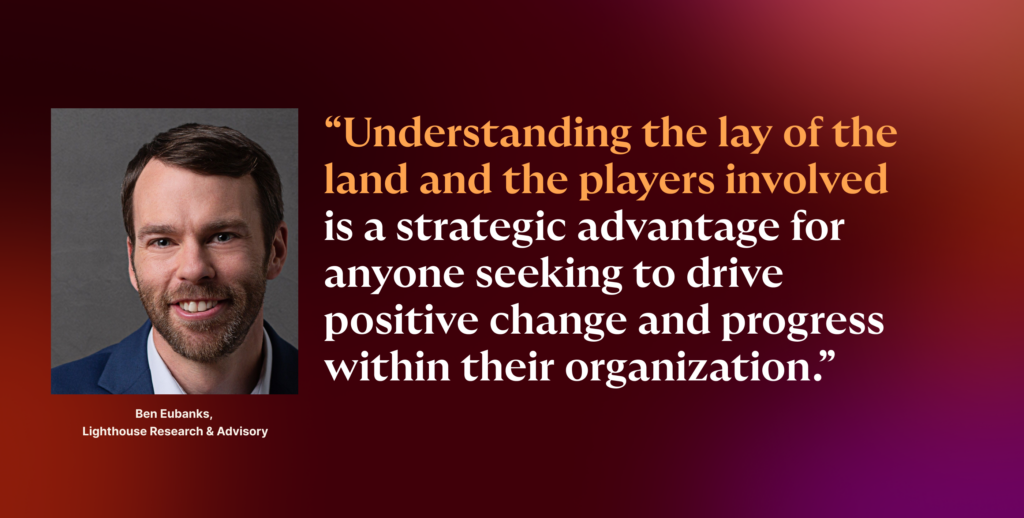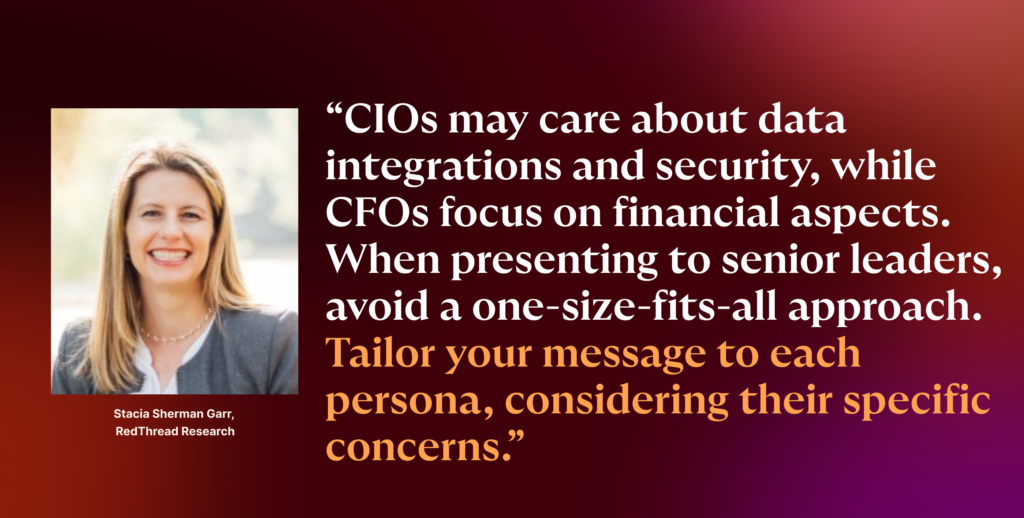In the latest edition of the People Analytics Sessions, we welcomed two research experts, Stacia Sherman Garr and Ben Eubanks, who walked us through the many aspects of buying HR technology.
Read on to learn more about:
- How to research HR technology vendors
- How to navigate the buying process effectively
- Criteria to bear in mind when choosing a vendor
- ROI of HR tech and how to secure the buy-in
- Getting to a position of authority on buying and budget
Researching HR tech and cutting through the marketing noise
Stacia Sherman Garr is Co-Founder of Red Thread Research – a human capital research analytics advisory firm, conducting vendor research and providing a “long short list” of vendors to choose from, and is a high-quality, unbiased source of information that helps HR people make better decisions in the market.
Ben Eubanks is a Chief Research Officer for Lighthouse Research and Advisory, conducting research on the HR technology market and helping others see what tools are out there, how to differentiate them, and what employers are looking for. In his words, it is by focusing on real-world issues and the ability of vendors to solve them, that HR professionals can make more informed decisions.
How to navigate the buying process effectively
In Ben’s view, knowing what problem you want to solve is where to start when thinking about buying HR tech.
“Whether you’re embarking on this journey for the first time at a new company or you’ve tackled it before, each organization has its unique dynamics, including politics, power struggles, and control structures. These factors significantly influence your decision-making process.”
The second thing Ben advises to keep in mind is that you should know who is making decisions within your company.
“In the corporate landscape, it’s crucial to identify the key stakeholders and decision-makers within your organization. You need to know who holds the influence, who you should collaborate with, and how to navigate the internal dynamics. It’s like recognizing the key figures at the heart of your company’s operations and ensuring you’re aligned with their goals and expectations.”

Also, convincing the right way is really important, says Ben.
Ben himself, touched upon a mistake he had made when pitching HR technology to leadership for the first time.
“I simply said, ‘This will make my job easier.’ But here’s the harsh reality: nobody cares if it makes your life easier. The core requirement is that the technology must have a tangible impact on the business and benefit the workforce. It has to deliver a clear return on investment (ROI).”
He learned that the key is to focus on how it will serve the broader workforce, how it will empower line managers to be more effective, and how it will provide executive leadership with deeper insights into the business.
This also especially holds true in the realm of people analytics, where having a keen understanding of how various personas within the organization will benefit is crucial.
Another thing is not totally surprising leaders with new technology!
“Instead, include them in discussions during the later stages. They don’t need to see every demo, but it’s essential to get their input, especially if the technology is end-user-focused. Let employees have a say in the usability and intuitiveness of the tool. By doing this, you’ll create champions within your organization who can vouch for the technology’s effectiveness and advocate for its adoption.”
Meanwhile Stacia brought up another key perspective, highlighting the need to adapt your approach based on your organization’s culture and values.
“Know your organization’s culture. If it’s employee-centric, make that a focal point. Every HR professional should recognize that they are the experts within their organization, intimately understanding its needs and culture. This insight provides you with the leverage to steer conversations in the right direction.”

In Stacia’s view, while Ben’s experience about no one caring if HR tech makes HRs’ job easier is generally accurate, understanding your HR organization’s strategic objectives and presenting HR tech in light of those objectives that is key.
Choosing the right vendor
Stacia and Ben outlined several points that can help in making choices that don’t lock you into a system and help you choose right:
Vendor’s roadmap
Consider your current requirements and future needs. Assess the vendor’s roadmap to see if it aligns with your organization’s growth and direction. Can you influence the vendor to align with your vision if they’re not there yet? Understanding where the vendor is headed is crucial to ensuring they’ll evolve with you.
Optionality in implementation
Be thoughtful about what aspects of the vendor’s offerings you implement and when. For instance, in the context of people analytics technology, you might start with data cleaning and integration and later introduce employee-facing components. This phased approach allows you to maintain flexibility and make adjustments as you learn more about the system’s performance.
Contract consideration
Pay close attention to your contracts. Avoid lengthy commitments if you have reservations. Start with a pilot to test the waters and ensure everything aligns with your expectations. This approach ensures that you’re not locked into a long-term contract prematurely.
Due diligence
Ben emphasizes the importance of due diligence when examining a vendor’s product roadmap. This includes asking to see their roadmap from two years ago and assessing which milestones they’ve achieved. Some vendors may keep demoing a product that’s not yet live, so it’s crucial to ensure you evaluate the actual, live product for a more accurate assessment.
ROI of HR tech and how to get approval
ROI of HR tech is a critical factor when seeking approval.
While calculating ROI in HR tech can be challenging, it’s essential to demonstrate the potential impact on the business. Typically, retention is a common ROI metric, but it can be challenging to establish causation.
To address this, Ben suggests focusing on specific outcomes such as improved communication with the workforce, reduced absenteeism, or decreased no-show rates for new hires. By pinpointing these areas, you can present a stronger case for ROI.
Stacia emphasizes considering intangible costs, such as the opportunity cost of not having the technology. What decisions are being made without the technology, and how could decision quality improve with it? This approach provides a more comprehensive view of the potential ROI.
Ben talked about the value of taking a conservative approach, stating that it’s challenging for financial teams to push back when you’ve taken every chance to be both conservative and realistic in your projections.
“Demonstrating a strong ROI while being conservative in your estimates can gain the approval of financial stakeholders.”
Both Ben and Stacia recommend addressing the costs of doing nothing.
“Delaying the implementation of HR tech also incurs a cost, and this aspect should be taken into account when presenting the ROI case. The opportunity cost of not having the technology should be emphasized as well.”
Buying authority
Determining your budget or buying authority within your organization can vary based on the company’s size, structure, and policies. Ben and Stacia provide practical insights for understanding and leveraging your budget or buying authority effectively.
As an Internal Person…
Establish clear thresholds
“Some organizations have predefined thresholds for making purchasing decisions without additional approvals. These limits are typically based on the employee’s role, level, or department. Identifying these thresholds can help you gauge your buying authority.”
Request approvals
“In cases where you’re unsure of your buying authority, don’t hesitate to ask for approval. Continually seek clarity by engaging with relevant stakeholders and superiors. You’ll find your buying limits by asking until you receive a definitive response.”
As a Vendor…
Understand the organization
When selling HR tech solutions, it’s essential to understand the organizational structure of your potential clients, Ben points out.
“Determine who the key decision-makers are and their level of influence.”
It’s a Team Sport
In many HR technology decisions, the process is collaborative. Be aware that multiple decision-makers and teams can be involved, even in organizations where a single person might not have significant budget authority. Ensure you engage with the entire decision-making team and highlight the value your product brings to each stakeholder.
“AI is the future of everything, apparently…”
Stacia points out how important it is to have a deep understanding of what different pieces of technology can do.
The landscape of HR technology can be complex, and it’s important to discern the strengths and capabilities of different solutions. She also says to be careful to not get swayed by marketing claims.
“Ask for demonstrations and real-world use cases to validate a technology’s capabilities.”
Another thing is that with the increasing use of AI in HR technology, transparency is critical.
“Ensure that you understand how AI works within the solutions you’re evaluating. Be cautious of “black box” AI, especially when dealing with generative AI, as it can pose challenges related to data control and accuracy. Know whether AI is being used for natural language processing or for more advanced applications.”
When evaluating HR technology vendors, be open to asking questions, seek clarification, and push back when necessary. Vendors should be able to provide clear explanations of their technology’s capabilities and should address any concerns you have.
Your role as a buyer includes ensuring the technology aligns with your organization’s needs and values.
Takeaways
Buying HR technology is a complex process and there are a lot of things to keep in mind.
Here is a quick summary of what we’ve covered in the session:
- Thorough research, understanding your organization’s unique dynamics, and focusing on tangible business impact are truly important.
- Choosing the right vendor involves evaluating their roadmap, optionality, contracts, and risks.
- Demonstrating ROI and addressing the costs of doing nothing are essential for approval.
- Buying authority varies and can be established by understanding thresholds or seeking approvals.
- AI is shaping the future, so it’s essential to understand technology capabilities, demand transparency, and ask questions when evaluating HR tech vendors.
Interested in joining sessions like these with top industry experts, networking with like-minded peers in the field of people analytics, gaining insights from professionals, and advancing your career? Join the People Analytics Lounge →